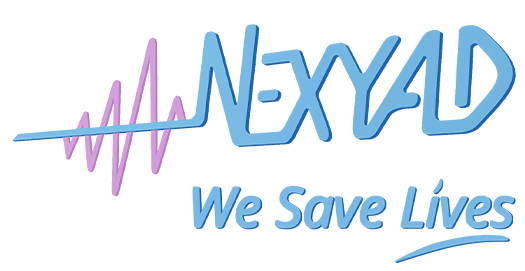ESTIMATION EMBARQUEE DU RISQUE ROUTIER CORRELEE A L’ACCIDENTOLOGIE :
UN PROBLEME ENTIEREMENT RESOLU ET UN PRODUIT SUR ETAGERE DISPONIBLE
par NEXYAD
INTRODUCTION
Mesurer la sécurité routière en fonction du contexte vécu par le conducteur est un sujet qui intéresse :
. les constructeurs automobiles, qui peuvent informer le conducteur d’éventuels dangers
. les développeurs du véhicule autonome qui ont besoin de prouver que le robot de conduite est
capable de minimiser le risque routier
. les gestionnaires de flottes et les assureurs qui souhaitent mesurer le risque pris par les conducteurs
. les gestionnaires de l’infrastructure routière qui cherchent à aménager les routes pour baisser le risque
d’accident
La société NEXYAD a développé un module embarqué, SafetyNex, qui permet d’estimer en temps réel le risque.
LES IDEES PRECONCUES CONCERNANT LE STYLE DE CONDUITE ET L’ACCIDENTOLOGIE
Beaucoup d’essais ont été réalisés ou en cours de réalisation, surtout par les assureurs et les gestionnaires
de flottes, pour mesurer ce qui s’appelle « le style de conduite ».
L’hypothèse est que certains conducteurs sont plus « nerveux » que d’autres, et que cela a un impact sur
l’accidentologie : ceux qui accélèrent ou freinent assez souvent brutalement seraient des « mauvais conducteurs », alors que ceux qui ont une conduite plus tranquille seraient des « bons » conducteurs.
Cette hypothèse est contredite par les faits. Il n’y a pas de liaison statistique entre le style de conduite et
l’accidentologie.
Formellement, chacun conçoit très bien que si un conducteur conduit très tranquillement, sans freiner, sans
accélérer, à 30 km/h, et qu’il grille un stop … son style de conduite est tranquille mais très accidentogène.
On voit alors qu’au-delà de la liaison statistique éventuelle, il ne peut y avoir de relation de cause à effet.
Toutes les expérimentations qui ont été menées ont conduit à ce résultat.
Toutes celles qui seront menées, basées sur le seuillage plus ou moins intelligent des valeurs d’accélérations
sont vouées à l’échec. Il ne faut pas confondre éco-conduite et conduite sûre.
Le style de conduite en lui-même ne peut être exploité qu’en regard :
. de l’infrastructure sur laquelle le véhicule évolue
. du trafic (présence d’autres usagers de la route)
. des conditions météo (visibilité, adhérence, …)
. du niveau d’attention du conducteur (distraction, hypovigilance, endormissement, …)
NEXYAD a développé une solution évolutive capable de prendre en compte tous ces facteurs.
SafetyNex en version « labo » est donc capable d’estimer le risque lié à la conduite de façon complète.
La version 2.1 de SafetyNex, en cours de déploiement, prend en compte l’adéquation du style de conduite au type et à la forme de l’infrastructure (ruptures sur les itinéraires, virages, passages piétons, croisements, …).
Cette version a été volontairement réduite car elle donne déjà une corrélation du risque estimé avec
l’accidentologie de plus de 90%, et elle est déployable à très bas coût :
. sur smart phone
. sur boîtier électronique (développé par un équipementier automobile de rang 1, sans utilisation de la prise OBD)
CORRELATION ENTRE L’ESTIMATION DU RISQUE PAR SafetyNex V2.1 ET L’ACCIDENTOLOGIE
NEXYAD a participé à des programmes de recherche collaborative depuis 2001, et a pu de cette manière collaborer avec des experts de l’équipement des routes.
En particulier, le programme de recherche SARI a conduit à des travaux de détection de ce que les experts appellent une « rupture sur l’itinéraire ». Par exemple, un virage peut constituer un grand danger lorsqu’il arrive derrière une longue ligne droite, alors que le même virage ne sera pas dangereux sur une route de montagne.
NEXYAD a publié un article lors de la conférence sur la Sécurité routière le 6 Mai 2010 à Paris : PRAC 2010 Prévention des Risques et Aide à La Conduite, Session 1 Caractérisation du risque routier vs. infrastructure « Evaluation du risque routier pour l’aide à la conduite ou le diagnostic de l’infrastructure », Johann Brunet, Pierre Da Silva Dias, Gérard Yahiaoui, PRAC 2010, Mai 2010, Paris.
Les travaux qui ont conduit à cette publication ont été intégrés au produit SafetyNex. Cela signifie que par construction, le risque estimé par SafetyNex est corrélé à l’accidentologie. Cela est vrai par construction, et NEXYAD a réalisé des essais sur routes, en ville, sur autoroutes, en zones urbaines, et a pu valider ce résultat.
PRINCIPE DE FONCTIONNEMENT DE SafetyNex V2.1
SafetyNex est un système à base de connaissances (système expert) qui applique les règles des experts de l’équipement. Ces règles sont rangées dans une base de règles sous une forme mathématique qui permet de les adapter de manière graduelle aux caractéristiques réelles de l’infrastructure.
Les entrées obligatoires sont :
. la carte de navigation et le GPS : afin de scruter la forme et les caractéristiques de l’infrastructure située en aval du véhicule (virages avec leur rayon de courbure, points d’intérêt de type passage piéton, croisement de routes, etc …)
. la vitesse instantanée du véhicule.
A partir de ces deux entrées, SafetyNex évalue, par application des règles, l’adéquation de la vitesse d’approche du véhicule en fonction du niveau de difficulté et de danger d’accidents de l’infrastructure.
Un conducteur sportif qui accélère fort, freine fort, mais passe les endroits dangereux à faible vitesse aura un risque faible.
Un conducteur tranquille qui grille un stop à 30 km/h mais qui n’accélère ni ne freine presque jamais aura un risque très élevé.
On le voit, SafetyNex n’est pas corrélé à la valeur absolue des accélérations, mais à l’adaptation FACTUELLE de la vitesse au type de difficulté de l’infrastructure, à chaque instant.
Des entrées supplémentaires (optionnelles) sont déjà prévue, et peuvent permettre de moduler l’estimation du risque pour la rendre encore plus précise :
. l’adhérence mobilisable (si l’on dispose d’un capteur, à connecter à l’entrée prévue à cet effet de SafetyNex)
. la météo (si l’on dispose de l’information spatio temporelle, à connecter à l’entrée prévue à cet effet de SafetyNex)
. la visibilité atmosphérique (si l’on dispose d’une mesure adéquate : exemple : une caméra et le module de mesure de visibilité atmosphérique VisiNex)
. la distance à d’éventuels obstacles ‘si l’on dispose d’une estimation adéquates : exemple : un radar, un lidar, ou une caméra avec les modules RoadNex et ObstaNex)
. un coefficient de distraction du conducteur (si l’on observe le conducteur avec une caméra et/ou si l’on surveille l’activité de son téléphone mobile, etc …)
Toutes ces entrées supplémentaires sont déjà prévues dans SafetyNex, mais elles augmentent le coût de déploiement de la solution en impliquant des capteurs (caméra, …) et de la puissance de calcul supplémentaire en amont de SafetyNex pour traiter les signaux et les images issus des capteurs optionnels.
L’utilisation de SafetyNex V2.1 avec uniquement les entrées obligatoires permet déjà une corrélation très forte du risque estimé avec l’accidentologie. Nous préconisons d’implanter cette version, déjà infiniment plus efficace que toutes les mesures embarquées que NEXYAD a pu découvrir dans son activité de veille.
L’intérêt de SafetyNex est que l’avenir est déjà assuré : la loi de Moore faisant baisser rapidement le coût de l’électronique et de l’informatique embarquées, SafetyNex est prêt à accueillir les entrées supplémentaires, dès que les utilisateurs voudront intégrer les caméras et les capteurs.
UTILISATIONS TYPES DE SafetyNex V2.1
. Sociétés d’assurances :
– Pay how you Drive
– Modulation prédictive du bonus malus : le même accident dans les mêmes conditions ne conduit pas aux mêmes conclusions en fonction de l’historique cumulé et de l’enregistrement des dernières secondes du risque de SafetyNex.
– Génération muette d’une variable de risque, corrélée à l’accidentologie, pour aider les actuaires à affiner la tarification
. Les gestionnaires de flottes
. Equipementiers automobile :
– Alarme sur risque
– Navigation intelligente capable de conseiller le conducteur
. Ingénieurs et chercheurs du véhicule autonome :
– Evaluation de la qualité de conduite générée par le robot
CONCLUSION
L’estimation embarquée du risque routier est aujourd’hui un problème résolu par un produit sur étagère, SafetyNex, déployable dès maintenant
à bas coût sur :
. téléphones mobiles
. boitier électronique d’un équipementier de rang 1 de l’automobile.
Et déjà prévu pour intégrer (dès que le coût est jugé acceptable) des capteurs d’adhérence et des caméras (par exemple) pour estimer le trafic et la visibilité atmosphérique, ainsi que des informations telles que la météo et la distraction du conducteur.
Tous ces éléments sont déjà traités par le système de règles de SafetyNex, si bien que l’outil peut évoluer rapidement à chaque baisse de coût des éléments capteurs et de la puissance de calcul rattachée à ces éléments capteurs.
Pour déployer SafetyNex, contacter NEXYAD : Olivier BENEL obenel@nexyad.net 01 39 04 13 60






 Example of Statitical Relationship in Risk Assessment : from Behaviour to Fatalities
Example of Statitical Relationship in Risk Assessment : from Behaviour to Fatalities


